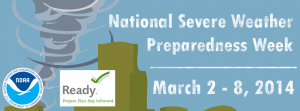This year, I am taking the time to learn how to prepare for severe weather during National Severe Weather Preparedness Week, March 2-8, 2014, sponsored by the Federal Emergency Management Agency (FEMA) and the National Oceanic Atmospheric Administration (NOAA).
Being prepared to act quickly could be a matter of survival. This is especially evident during the threat of severe weather. The deadliest and most destructive tornado of 2013, an EF-5 on May 20 in Moore, Oklahoma caused more than $2 billion in property damage. Even though severe weather was anticipated days in advance, many in the impacted areas said they did not have a plan and were caught unprepared. And while spring tends to produce more tornadoes, they’re not uncommon in fall. On Nov. 17, a late season tornado outbreak that struck seven Midwestern states became the most active tornado day of 2013 with a total of 74 tornadoes.
Here is what you can do to prepare:
Know Your Risk – Hurricanes, tornadoes and storms – every state in the United States experiences severe weather. Visit weather.gov to get the latest on weather threats.
Take Action – Take the next step in severe weather preparedness by creating a family communications plan, putting an emergency kit together, keeping important papers and valuables in a safe place and learning about Wireless Emergency Alerts.
Check out the Emergency Management Services page on the City’s website for other helpful hints and links to other preparedness organizations.

Read Full Post »






